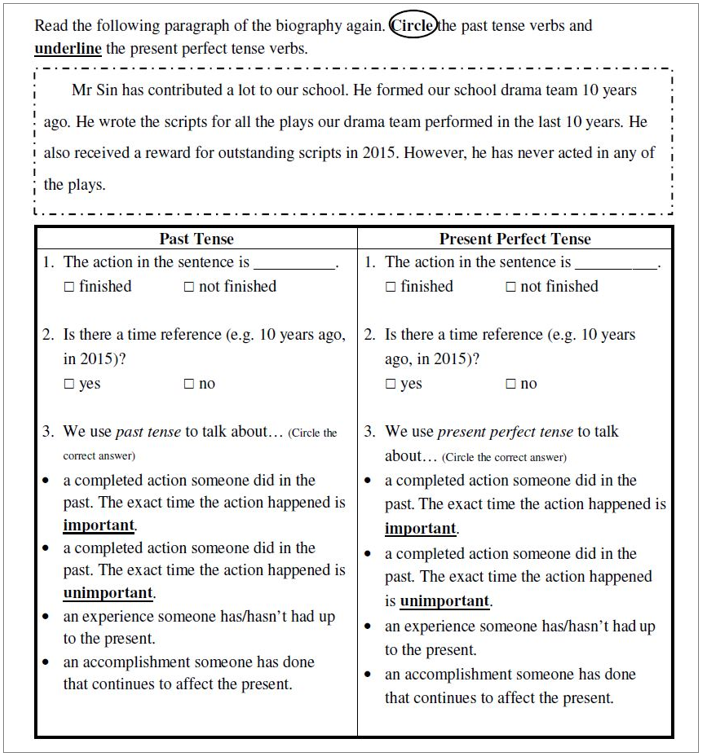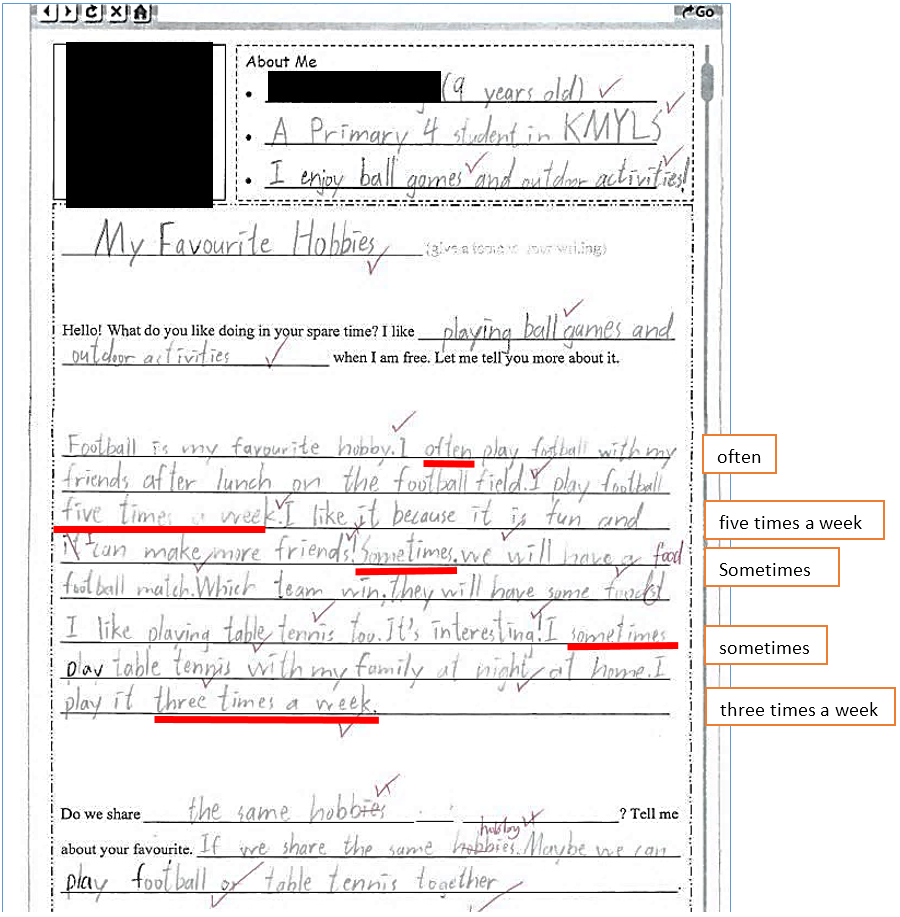Promoting a text-based approach to grammar learning and teaching: Towards Reading to Learn
Background
The seven learning goals of primary education focus on promoting the whole-person development of our younger learners (Education Bureau, 2018). These include enhancing students' language proficiency, strengthening their self-directed learning skills, and cultivating in them a habit of reading. Based on this central curriculum framework, the English panel of Kwong Ming Ying Loi School (KMYLS) has worked towards designing and implementing grammar lessons in which reading plays a significant role. One overall goal of this text-based approach to grammar learning and teaching is to nurture lifelong and self-directed learners through Reading to Learn. To this end, the teachers have exposed students to reading and analysing a variety of text types. They have also supported students to discover, understand, and reflect on grammar use in context.
Level(s)
P4-5
Strategies used
The teachers have employed three key strategies while planning and implementing their school English Language curriculum:
Extending grammar learning and teaching from the sentence level to the text level
This involves:- exposing students to reading and analysing a diverse collection of text types (for example, blog entries, newsletters, and personal profiles); and
- exemplifying through repeated structures in context the relationship between forms and functions (for example, how grammar makes meanings in different texts).
Adopting an inductive approach to the learning and teaching of text grammar
This involves:- guiding students to explore (through, for example, text comparison, and guided discovery activities) the grammatical features salient to different text types; and
- supporting students to make hypotheses about, and reflect upon, the grammar use in context (for example, how grammatical choices are used as means to shape the tone, style and register of a text).
Creating meaningful opportunities for students to reflect on and apply their grammar learning
This involves:- engaging students in practising and using the target grammar items for communication (for example, through creating and presenting relevant texts); and
- integrating the teaching of grammar with the four language skills.
What happened
Extending grammar learning and teaching from the sentence level to the text level
Teaching grammar at the text level goes beyond the teaching of isolated grammar rules and terms. By extending grammar learning from the sentence level to the text level, students are enabled to develop a more nuanced understanding of the relationship between language and context (for example, how grammar makes meanings in different texts). To promote the learning and teaching of grammar in context, teachers from KMYLS used reading as an entry point. Through careful planning and adaptation, they developed and guided students to read a diverse collection of text types (see Table 1). Among other things, these reading materials were used to exemplify in situ some text-specific grammatical features (for example, the use of comparatives and superlatives in survey reports, and the use of reflexive pronouns in diary entries).Levels
Text types
To exemplify the repeated use of…
P4
Survey reports
Comparatives and superlatives
Blog entries
Adverbs of frequency
Presentation scripts
Connectives to link similar ideas
Newsletters
Determiners
Reports
Questions and phrases of measures
Proposals
Future forms
P5
Diary entries
Reflexive pronouns
Guidelines and regulations
Imperatives
Personal profiles
Present perfect tense
Magazine articles
Pronouns
Product sketches
Gerunds and infinitives
Stories
Participial adjectives
Table 1: Strategic selection of text types
Adopting an inductive approach to the learning and teaching of text grammar
To nurture students' "learning to learn" competence, the teachers sought to develop all learners as active explorers of language. This involved considering learning and teaching as a process of enquiry and co-construction (vis-à-vis learning as a product of direct instruction, see Education Bureau, 2017). In the context of grammar learning and teaching, students were provided with opportunities to discover language patterns and rules for themselves. Drawing upon a variety of awareness-raising activities (for example, text comparison, and guided discovery), students were supported to: first, note the specific grammatical features of the different text types (cf. Table 1), and second, make hypotheses about these forms, alongside their communicative functions (see Figure 1, for example). Through this "inductive and discovery approach" (Curriculum Development Council & Hong Kong Examinations and Assessment Authority, 2021, p. 32), students were guided to consciously reflect upon the grammar use in various contexts. They were also enabled to consolidate and internalise their text grammar knowledge.
Figure 1. Guided discovery activity – An example
Creating meaningful opportunities for students to reflect on and apply their grammar learning
Finally, the teachers developed different meaningful tasks for students to interact with the target language. Together these helped learners reflect on and apply their knowledge of grammar in communication. Meanwhile, students were enabled to bring together the skills of reading, writing, listening, and speaking. For example, children were asked to interview their principal in one speaking task. During the process, they needed to consider the form, meaning, and use of different tenses. In addition to playing with the language in such a fun-filled context, students were constantly given the opportunities to demonstrate their text grammar knowledge through creating and editing relevant texts (cf. Table 1). This helps illustrate how the learning and teaching of text grammar could be effective in the context of improving writing skills (Curriculum Development Council, 2004), among other possible objectives.
Impact
Student level
Based on our ongoing analysis of student work, most learners have demonstrated heightened awareness of how grammar affects the coherence, structure, and tone of a text. Many are now able to choose and use appropriate forms to express different communicative meanings (see, for example, Figure 2). According to the teachers' observations and their formative assessments, many students have demonstrated increased motivation in learning, exploring, and using English Language. Some were more willing to take risks while performing different communicative tasks (not least as the teachers' pedagogy has shifted from focusing merely on grammatical accuracy, to putting equal emphasis as well on fluency).
Teacher level
Teachers have begun to see grammar as a "super-connector" in their school English Language curriculum. As was evident in their subject and unit plans, as well as our lesson observations, most teachers were able to integrate the learning and teaching of grammar with the four language skills. In our year-end professional development with all 19 members from the English panel, most teachers agreed (mean score = 4.53/5) that they had gained a better understanding of the theory and practice of promoting a text-based approach to grammar learning and teaching. When asked about building on and sustaining the change we had made, the majority (84%) expressed that they would continue employing similar strategies in their day-to-day teaching. According to the data of our year-end survey with the school, both the principal and the English panel chair agreed that teachers had improved strategies related to the teaching and assessment of text grammar (for example, making good use of student learning evidence for reviewing the effectiveness of grammar learning and teaching).

Figure 2. Using adverbs/adverb phrases to express frequency in a blog entry – A sample of student work
Curriculum level
First, in extending grammar learning and teaching from the sentence level to the text level, the teachers have introduced into their school English Language curriculum a diverse and appropriate collection of reading texts. These reading inputs, in addition to those from the textbooks, provided a text-rich environment and meaningful contexts for the learning and teaching of grammar. They also offered variety to cater for individual needs, interests and abilities. Second, in employing an inductive approach to the learning and teaching of text grammar, different awareness-raising activities were designed. Furthermore, meaningful opportunities were created for students to reflect on and apply their learning. Together these strategies have put Reading to Learn at the centre of the school's English Language curriculum.
Conclusion
To conclude this two-year project, some key facilitating factors have been identified:
A core team was formed in the first year to develop and pilot this new curriculum initiative. Such a powerful coalition – comprising the English panel chair, the two assistant panel chairs, four English panel members, and the NETs – had met regularly to discuss planning, implementation, and evaluation.
This project was partly funded by SCOLAR through the "Grant Scheme on Promoting Effective English Language Learning in Primary Schools" (2020/21). The school had used this source of funding strategically to employ an additional teacher in the first year. In so doing, space was created for the core team members to develop curriculum materials.
The teachers have developed the practice of collecting learning and teaching evidence (for example, samples of student work and lesson videos). All data were reviewed regularly to gauge the extent to which the curriculum objectives and success criteria were met.
In the second year of the project, the core team was expanded to include all P4 and P5 teachers. By involving all relevant panel members in cycles of planning, implementation, and evaluation, the school was able to further engage everyone in helping implement and sustain the change.
In promoting a text-based approach to grammar learning and teaching, teachers from KMYLS have illustrated how we might nurture lifelong and self-directed learners through Reading to Learn. This was primarily through: first, designing lessons in which reading plays a significant part, and second, providing meaningful opportunities for students to reflect on and apply their learning. While other schools might draw upon different developmental focuses as entry points, the case of KMYLS offers useful insights into optimising the school English Language curriculum to foster students' whole-person development.
Bibliography
Curriculum Development Council and the Hong Kong Examinations and Assessment Authority. (2021). English Language Education Key Learning Area Curriculum and Assessment Guide (Secondary 4-6). Hong Kong: Author.
Curriculum Development Council. (2004). English Language Education Key Learning Area: English Language Curriculum Guide (Primary 1-6). Hong Kong: Author.
Education Bureau. (2017). Effective learning and teaching: Developing lifelong and self-directed learners. In Secondary Education Curriculum Guide. Hong Kong: Author.
Education Bureau. (2018). Seven learning goals of primary education. Hong Kong: Author.
Kwong Ming Ying Loi School
Eddy LI (Language Support Officer)